Recognise Health Body System
VerifiedAdded on 2022/12/23
|12
|3014
|66
AI Summary
This document provides information about the human body system and its importance in healthcare. It covers topics such as understanding medical terms, the structure and function of different body systems, and the role of body systems in maintaining health. The document also includes case studies that highlight the application of knowledge in real-life scenarios. Subject: Health Body System, Course Code: N/A, Course Name: N/A, College/University: N/A
Contribute Materials
Your contribution can guide someone’s learning journey. Share your
documents today.
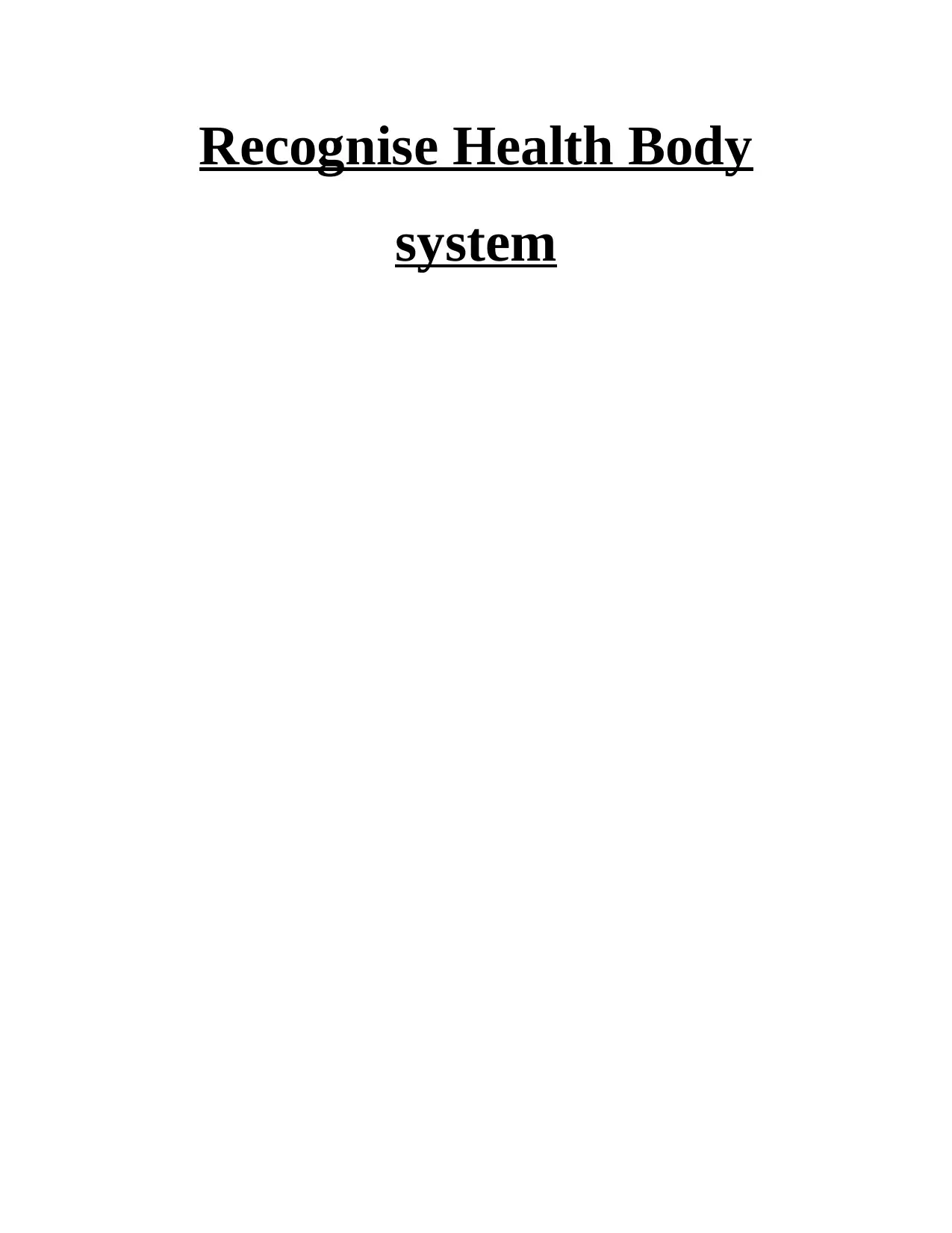
Recognise Health Body
system
system
Secure Best Marks with AI Grader
Need help grading? Try our AI Grader for instant feedback on your assignments.
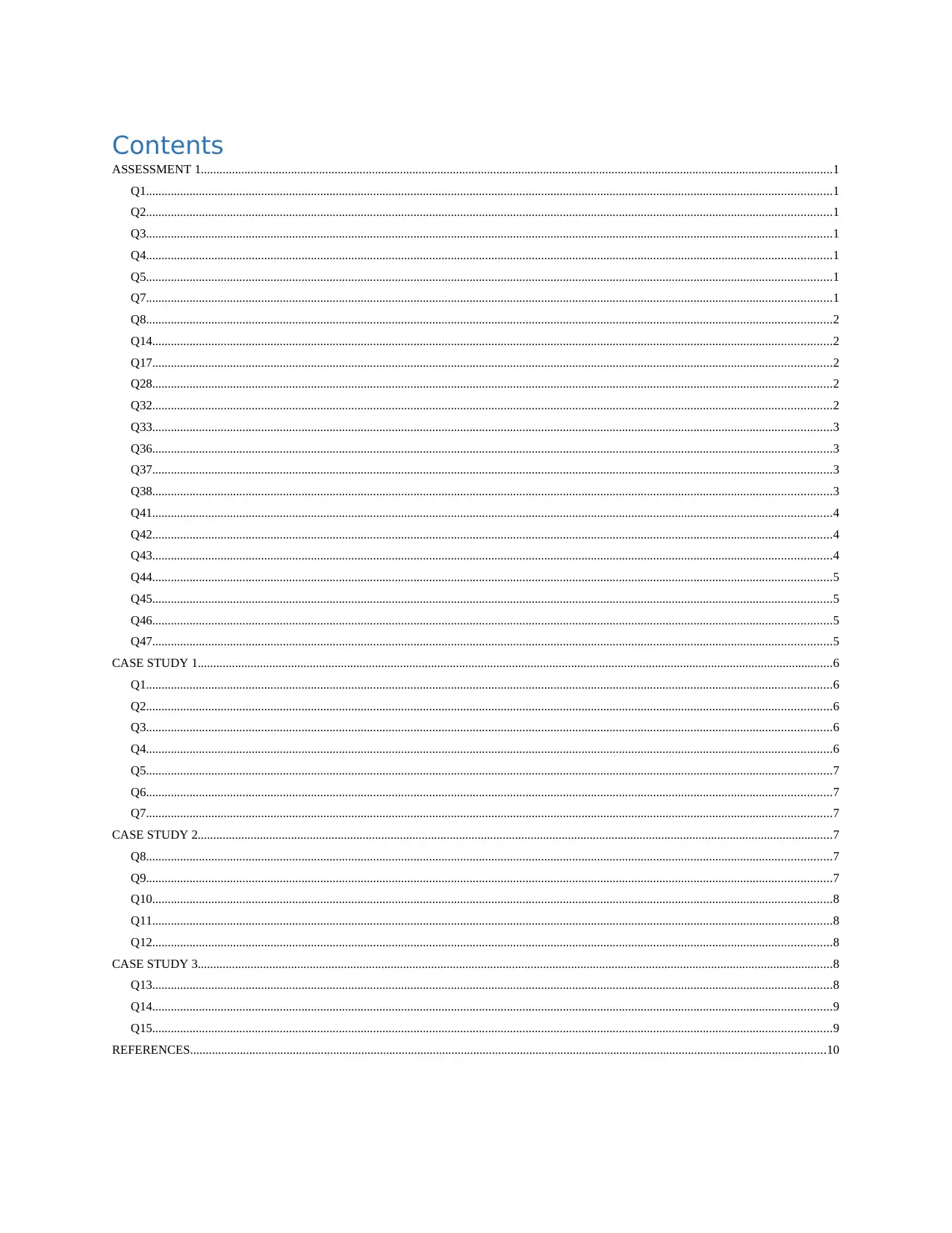
Contents
ASSESSMENT 1...........................................................................................................................................................................................................1
Q1............................................................................................................................................................................................................................1
Q2............................................................................................................................................................................................................................1
Q3............................................................................................................................................................................................................................1
Q4............................................................................................................................................................................................................................1
Q5............................................................................................................................................................................................................................1
Q7............................................................................................................................................................................................................................1
Q8............................................................................................................................................................................................................................2
Q14..........................................................................................................................................................................................................................2
Q17..........................................................................................................................................................................................................................2
Q28..........................................................................................................................................................................................................................2
Q32..........................................................................................................................................................................................................................2
Q33..........................................................................................................................................................................................................................3
Q36..........................................................................................................................................................................................................................3
Q37..........................................................................................................................................................................................................................3
Q38..........................................................................................................................................................................................................................3
Q41..........................................................................................................................................................................................................................4
Q42..........................................................................................................................................................................................................................4
Q43..........................................................................................................................................................................................................................4
Q44..........................................................................................................................................................................................................................5
Q45..........................................................................................................................................................................................................................5
Q46..........................................................................................................................................................................................................................5
Q47..........................................................................................................................................................................................................................5
CASE STUDY 1............................................................................................................................................................................................................6
Q1............................................................................................................................................................................................................................6
Q2............................................................................................................................................................................................................................6
Q3............................................................................................................................................................................................................................6
Q4............................................................................................................................................................................................................................6
Q5............................................................................................................................................................................................................................7
Q6............................................................................................................................................................................................................................7
Q7............................................................................................................................................................................................................................7
CASE STUDY 2............................................................................................................................................................................................................7
Q8............................................................................................................................................................................................................................7
Q9............................................................................................................................................................................................................................7
Q10..........................................................................................................................................................................................................................8
Q11..........................................................................................................................................................................................................................8
Q12..........................................................................................................................................................................................................................8
CASE STUDY 3............................................................................................................................................................................................................8
Q13..........................................................................................................................................................................................................................8
Q14..........................................................................................................................................................................................................................9
Q15..........................................................................................................................................................................................................................9
REFERENCES............................................................................................................................................................................................................10
ASSESSMENT 1...........................................................................................................................................................................................................1
Q1............................................................................................................................................................................................................................1
Q2............................................................................................................................................................................................................................1
Q3............................................................................................................................................................................................................................1
Q4............................................................................................................................................................................................................................1
Q5............................................................................................................................................................................................................................1
Q7............................................................................................................................................................................................................................1
Q8............................................................................................................................................................................................................................2
Q14..........................................................................................................................................................................................................................2
Q17..........................................................................................................................................................................................................................2
Q28..........................................................................................................................................................................................................................2
Q32..........................................................................................................................................................................................................................2
Q33..........................................................................................................................................................................................................................3
Q36..........................................................................................................................................................................................................................3
Q37..........................................................................................................................................................................................................................3
Q38..........................................................................................................................................................................................................................3
Q41..........................................................................................................................................................................................................................4
Q42..........................................................................................................................................................................................................................4
Q43..........................................................................................................................................................................................................................4
Q44..........................................................................................................................................................................................................................5
Q45..........................................................................................................................................................................................................................5
Q46..........................................................................................................................................................................................................................5
Q47..........................................................................................................................................................................................................................5
CASE STUDY 1............................................................................................................................................................................................................6
Q1............................................................................................................................................................................................................................6
Q2............................................................................................................................................................................................................................6
Q3............................................................................................................................................................................................................................6
Q4............................................................................................................................................................................................................................6
Q5............................................................................................................................................................................................................................7
Q6............................................................................................................................................................................................................................7
Q7............................................................................................................................................................................................................................7
CASE STUDY 2............................................................................................................................................................................................................7
Q8............................................................................................................................................................................................................................7
Q9............................................................................................................................................................................................................................7
Q10..........................................................................................................................................................................................................................8
Q11..........................................................................................................................................................................................................................8
Q12..........................................................................................................................................................................................................................8
CASE STUDY 3............................................................................................................................................................................................................8
Q13..........................................................................................................................................................................................................................8
Q14..........................................................................................................................................................................................................................9
Q15..........................................................................................................................................................................................................................9
REFERENCES............................................................................................................................................................................................................10
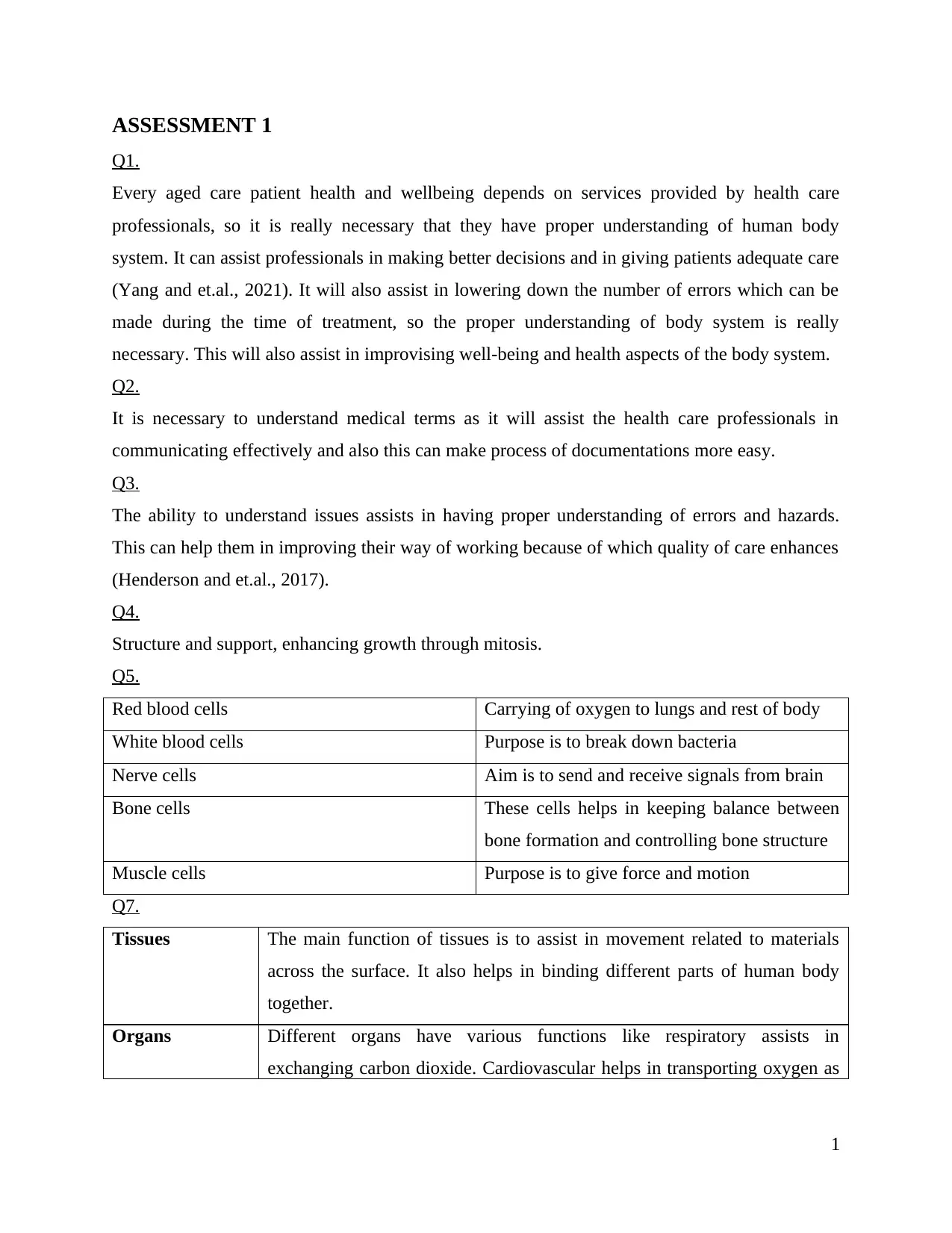
ASSESSMENT 1
Q1.
Every aged care patient health and wellbeing depends on services provided by health care
professionals, so it is really necessary that they have proper understanding of human body
system. It can assist professionals in making better decisions and in giving patients adequate care
(Yang and et.al., 2021). It will also assist in lowering down the number of errors which can be
made during the time of treatment, so the proper understanding of body system is really
necessary. This will also assist in improvising well-being and health aspects of the body system.
Q2.
It is necessary to understand medical terms as it will assist the health care professionals in
communicating effectively and also this can make process of documentations more easy.
Q3.
The ability to understand issues assists in having proper understanding of errors and hazards.
This can help them in improving their way of working because of which quality of care enhances
(Henderson and et.al., 2017).
Q4.
Structure and support, enhancing growth through mitosis.
Q5.
Red blood cells Carrying of oxygen to lungs and rest of body
White blood cells Purpose is to break down bacteria
Nerve cells Aim is to send and receive signals from brain
Bone cells These cells helps in keeping balance between
bone formation and controlling bone structure
Muscle cells Purpose is to give force and motion
Q7.
Tissues The main function of tissues is to assist in movement related to materials
across the surface. It also helps in binding different parts of human body
together.
Organs Different organs have various functions like respiratory assists in
exchanging carbon dioxide. Cardiovascular helps in transporting oxygen as
1
Q1.
Every aged care patient health and wellbeing depends on services provided by health care
professionals, so it is really necessary that they have proper understanding of human body
system. It can assist professionals in making better decisions and in giving patients adequate care
(Yang and et.al., 2021). It will also assist in lowering down the number of errors which can be
made during the time of treatment, so the proper understanding of body system is really
necessary. This will also assist in improvising well-being and health aspects of the body system.
Q2.
It is necessary to understand medical terms as it will assist the health care professionals in
communicating effectively and also this can make process of documentations more easy.
Q3.
The ability to understand issues assists in having proper understanding of errors and hazards.
This can help them in improving their way of working because of which quality of care enhances
(Henderson and et.al., 2017).
Q4.
Structure and support, enhancing growth through mitosis.
Q5.
Red blood cells Carrying of oxygen to lungs and rest of body
White blood cells Purpose is to break down bacteria
Nerve cells Aim is to send and receive signals from brain
Bone cells These cells helps in keeping balance between
bone formation and controlling bone structure
Muscle cells Purpose is to give force and motion
Q7.
Tissues The main function of tissues is to assist in movement related to materials
across the surface. It also helps in binding different parts of human body
together.
Organs Different organs have various functions like respiratory assists in
exchanging carbon dioxide. Cardiovascular helps in transporting oxygen as
1
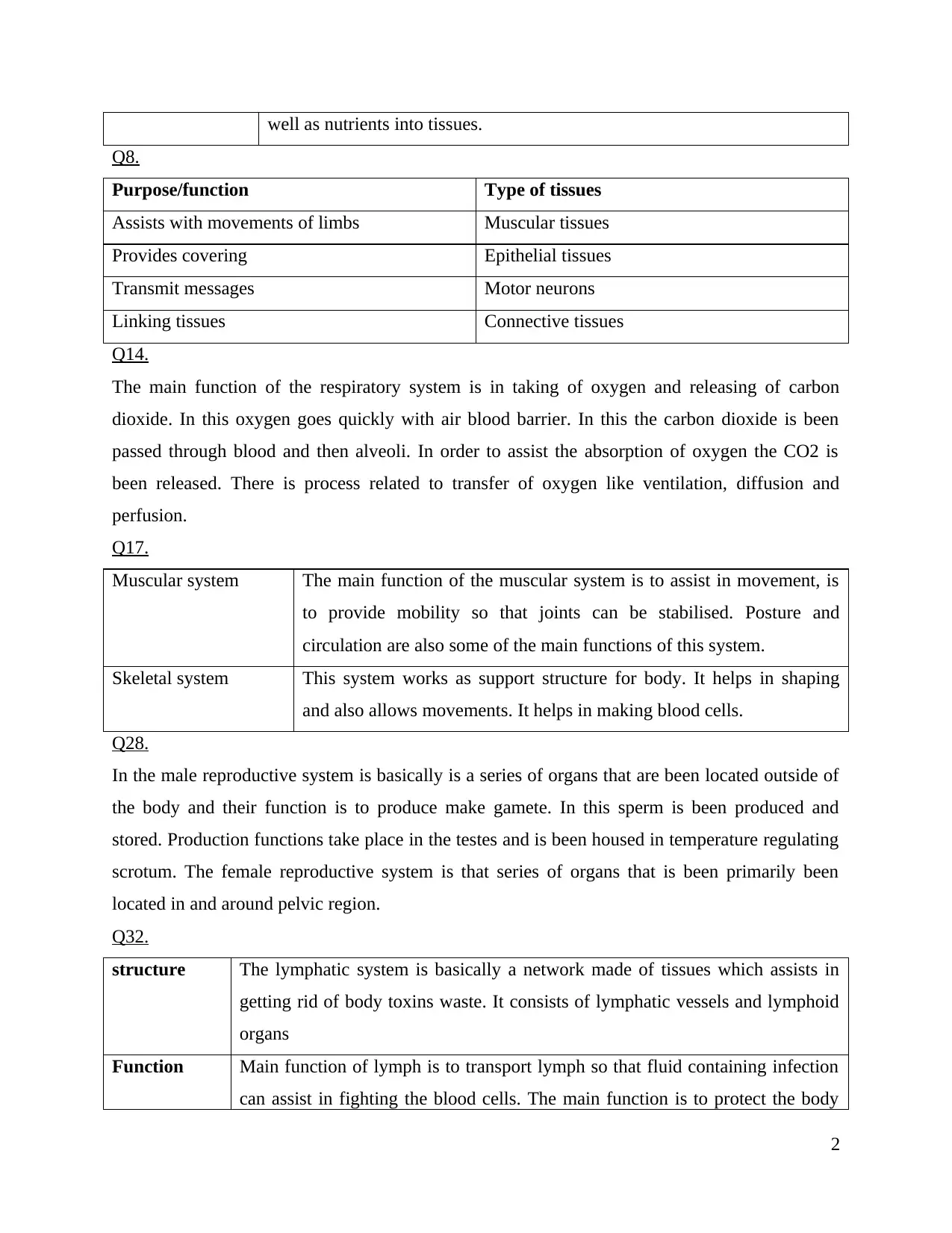
well as nutrients into tissues.
Q8.
Purpose/function Type of tissues
Assists with movements of limbs Muscular tissues
Provides covering Epithelial tissues
Transmit messages Motor neurons
Linking tissues Connective tissues
Q14.
The main function of the respiratory system is in taking of oxygen and releasing of carbon
dioxide. In this oxygen goes quickly with air blood barrier. In this the carbon dioxide is been
passed through blood and then alveoli. In order to assist the absorption of oxygen the CO2 is
been released. There is process related to transfer of oxygen like ventilation, diffusion and
perfusion.
Q17.
Muscular system The main function of the muscular system is to assist in movement, is
to provide mobility so that joints can be stabilised. Posture and
circulation are also some of the main functions of this system.
Skeletal system This system works as support structure for body. It helps in shaping
and also allows movements. It helps in making blood cells.
Q28.
In the male reproductive system is basically is a series of organs that are been located outside of
the body and their function is to produce make gamete. In this sperm is been produced and
stored. Production functions take place in the testes and is been housed in temperature regulating
scrotum. The female reproductive system is that series of organs that is been primarily been
located in and around pelvic region.
Q32.
structure The lymphatic system is basically a network made of tissues which assists in
getting rid of body toxins waste. It consists of lymphatic vessels and lymphoid
organs
Function Main function of lymph is to transport lymph so that fluid containing infection
can assist in fighting the blood cells. The main function is to protect the body
2
Q8.
Purpose/function Type of tissues
Assists with movements of limbs Muscular tissues
Provides covering Epithelial tissues
Transmit messages Motor neurons
Linking tissues Connective tissues
Q14.
The main function of the respiratory system is in taking of oxygen and releasing of carbon
dioxide. In this oxygen goes quickly with air blood barrier. In this the carbon dioxide is been
passed through blood and then alveoli. In order to assist the absorption of oxygen the CO2 is
been released. There is process related to transfer of oxygen like ventilation, diffusion and
perfusion.
Q17.
Muscular system The main function of the muscular system is to assist in movement, is
to provide mobility so that joints can be stabilised. Posture and
circulation are also some of the main functions of this system.
Skeletal system This system works as support structure for body. It helps in shaping
and also allows movements. It helps in making blood cells.
Q28.
In the male reproductive system is basically is a series of organs that are been located outside of
the body and their function is to produce make gamete. In this sperm is been produced and
stored. Production functions take place in the testes and is been housed in temperature regulating
scrotum. The female reproductive system is that series of organs that is been primarily been
located in and around pelvic region.
Q32.
structure The lymphatic system is basically a network made of tissues which assists in
getting rid of body toxins waste. It consists of lymphatic vessels and lymphoid
organs
Function Main function of lymph is to transport lymph so that fluid containing infection
can assist in fighting the blood cells. The main function is to protect the body
2
Secure Best Marks with AI Grader
Need help grading? Try our AI Grader for instant feedback on your assignments.
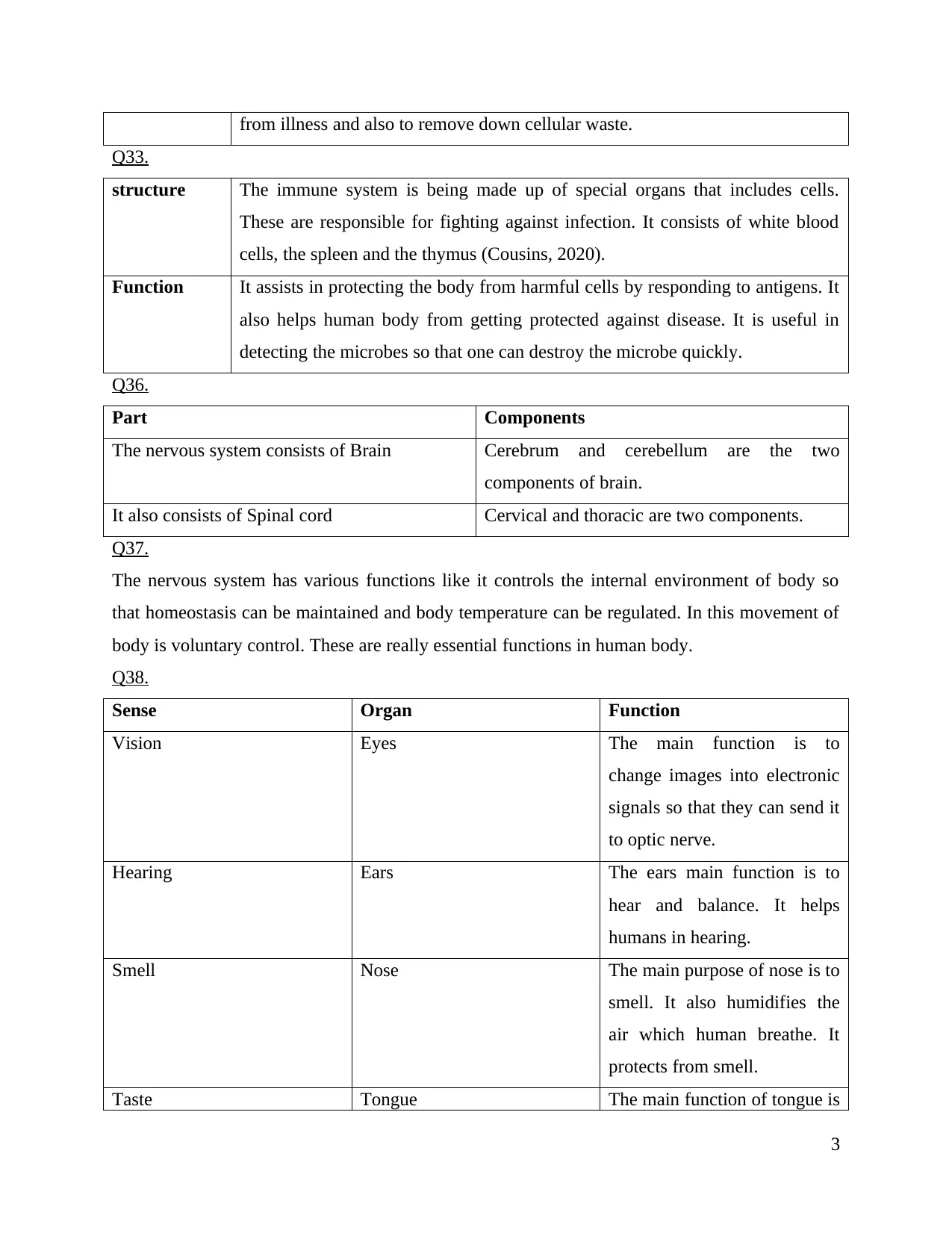
from illness and also to remove down cellular waste.
Q33.
structure The immune system is being made up of special organs that includes cells.
These are responsible for fighting against infection. It consists of white blood
cells, the spleen and the thymus (Cousins, 2020).
Function It assists in protecting the body from harmful cells by responding to antigens. It
also helps human body from getting protected against disease. It is useful in
detecting the microbes so that one can destroy the microbe quickly.
Q36.
Part Components
The nervous system consists of Brain Cerebrum and cerebellum are the two
components of brain.
It also consists of Spinal cord Cervical and thoracic are two components.
Q37.
The nervous system has various functions like it controls the internal environment of body so
that homeostasis can be maintained and body temperature can be regulated. In this movement of
body is voluntary control. These are really essential functions in human body.
Q38.
Sense Organ Function
Vision Eyes The main function is to
change images into electronic
signals so that they can send it
to optic nerve.
Hearing Ears The ears main function is to
hear and balance. It helps
humans in hearing.
Smell Nose The main purpose of nose is to
smell. It also humidifies the
air which human breathe. It
protects from smell.
Taste Tongue The main function of tongue is
3
Q33.
structure The immune system is being made up of special organs that includes cells.
These are responsible for fighting against infection. It consists of white blood
cells, the spleen and the thymus (Cousins, 2020).
Function It assists in protecting the body from harmful cells by responding to antigens. It
also helps human body from getting protected against disease. It is useful in
detecting the microbes so that one can destroy the microbe quickly.
Q36.
Part Components
The nervous system consists of Brain Cerebrum and cerebellum are the two
components of brain.
It also consists of Spinal cord Cervical and thoracic are two components.
Q37.
The nervous system has various functions like it controls the internal environment of body so
that homeostasis can be maintained and body temperature can be regulated. In this movement of
body is voluntary control. These are really essential functions in human body.
Q38.
Sense Organ Function
Vision Eyes The main function is to
change images into electronic
signals so that they can send it
to optic nerve.
Hearing Ears The ears main function is to
hear and balance. It helps
humans in hearing.
Smell Nose The main purpose of nose is to
smell. It also humidifies the
air which human breathe. It
protects from smell.
Taste Tongue The main function of tongue is
3
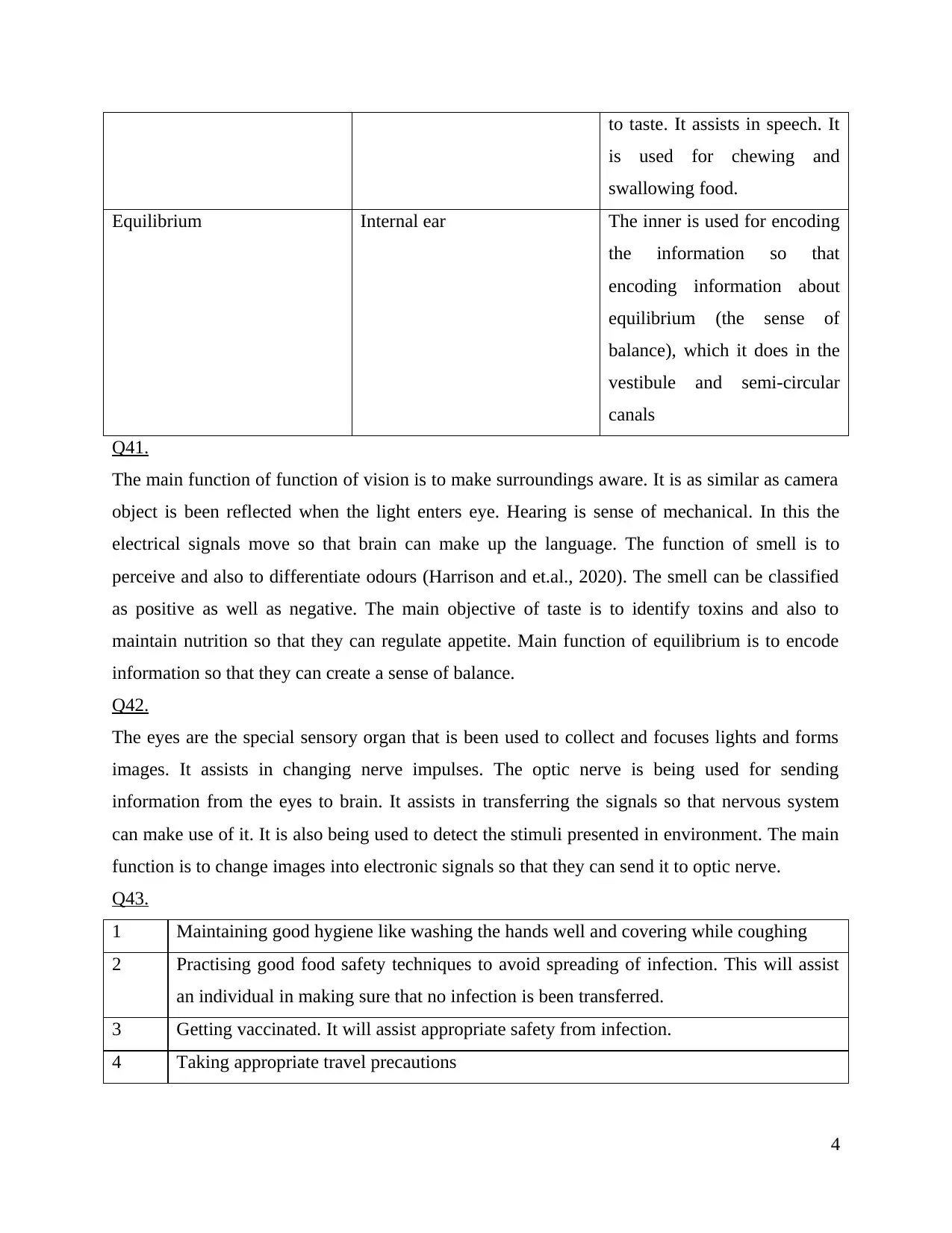
to taste. It assists in speech. It
is used for chewing and
swallowing food.
Equilibrium Internal ear The inner is used for encoding
the information so that
encoding information about
equilibrium (the sense of
balance), which it does in the
vestibule and semi-circular
canals
Q41.
The main function of function of vision is to make surroundings aware. It is as similar as camera
object is been reflected when the light enters eye. Hearing is sense of mechanical. In this the
electrical signals move so that brain can make up the language. The function of smell is to
perceive and also to differentiate odours (Harrison and et.al., 2020). The smell can be classified
as positive as well as negative. The main objective of taste is to identify toxins and also to
maintain nutrition so that they can regulate appetite. Main function of equilibrium is to encode
information so that they can create a sense of balance.
Q42.
The eyes are the special sensory organ that is been used to collect and focuses lights and forms
images. It assists in changing nerve impulses. The optic nerve is being used for sending
information from the eyes to brain. It assists in transferring the signals so that nervous system
can make use of it. It is also being used to detect the stimuli presented in environment. The main
function is to change images into electronic signals so that they can send it to optic nerve.
Q43.
1 Maintaining good hygiene like washing the hands well and covering while coughing
2 Practising good food safety techniques to avoid spreading of infection. This will assist
an individual in making sure that no infection is been transferred.
3 Getting vaccinated. It will assist appropriate safety from infection.
4 Taking appropriate travel precautions
4
is used for chewing and
swallowing food.
Equilibrium Internal ear The inner is used for encoding
the information so that
encoding information about
equilibrium (the sense of
balance), which it does in the
vestibule and semi-circular
canals
Q41.
The main function of function of vision is to make surroundings aware. It is as similar as camera
object is been reflected when the light enters eye. Hearing is sense of mechanical. In this the
electrical signals move so that brain can make up the language. The function of smell is to
perceive and also to differentiate odours (Harrison and et.al., 2020). The smell can be classified
as positive as well as negative. The main objective of taste is to identify toxins and also to
maintain nutrition so that they can regulate appetite. Main function of equilibrium is to encode
information so that they can create a sense of balance.
Q42.
The eyes are the special sensory organ that is been used to collect and focuses lights and forms
images. It assists in changing nerve impulses. The optic nerve is being used for sending
information from the eyes to brain. It assists in transferring the signals so that nervous system
can make use of it. It is also being used to detect the stimuli presented in environment. The main
function is to change images into electronic signals so that they can send it to optic nerve.
Q43.
1 Maintaining good hygiene like washing the hands well and covering while coughing
2 Practising good food safety techniques to avoid spreading of infection. This will assist
an individual in making sure that no infection is been transferred.
3 Getting vaccinated. It will assist appropriate safety from infection.
4 Taking appropriate travel precautions
4
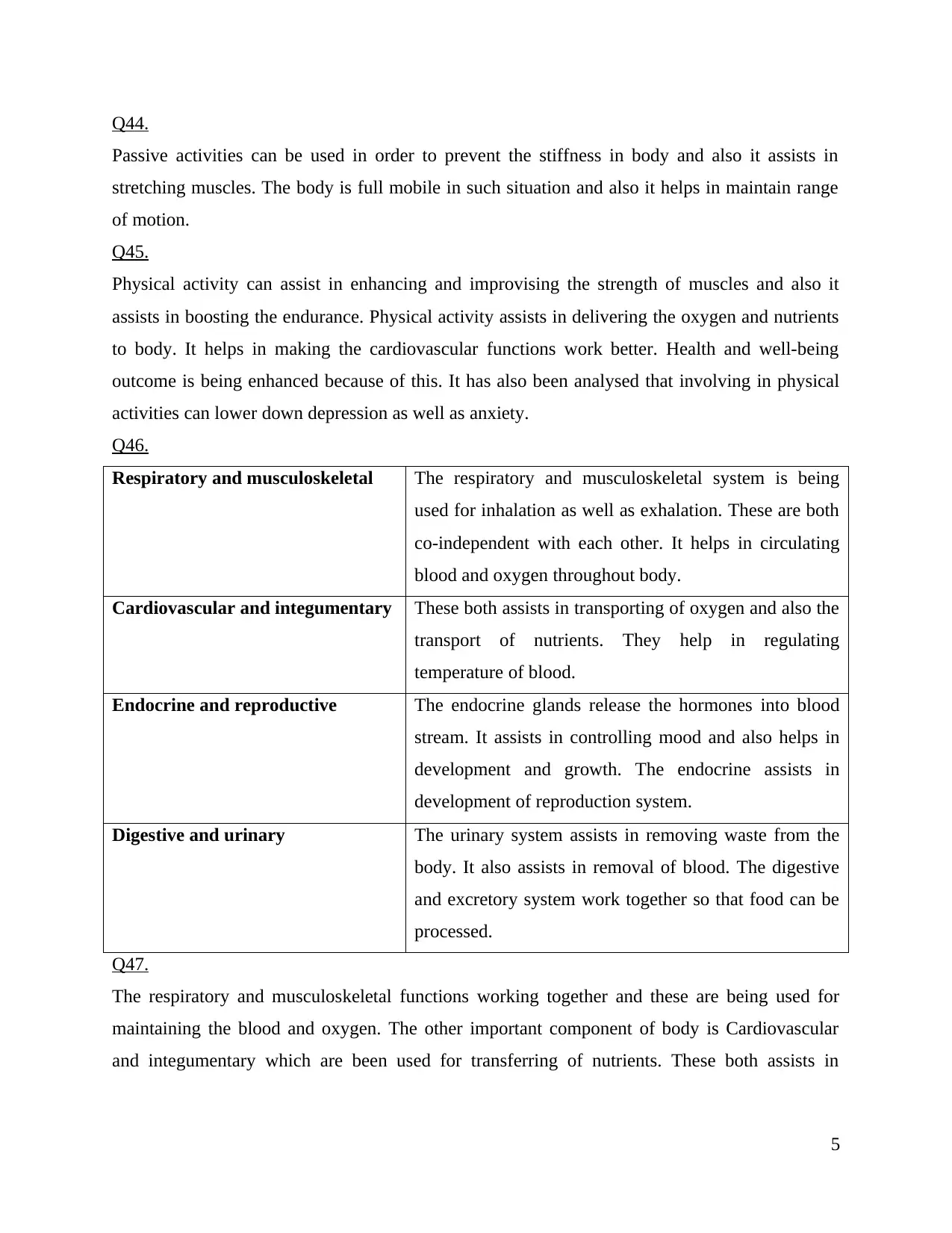
Q44.
Passive activities can be used in order to prevent the stiffness in body and also it assists in
stretching muscles. The body is full mobile in such situation and also it helps in maintain range
of motion.
Q45.
Physical activity can assist in enhancing and improvising the strength of muscles and also it
assists in boosting the endurance. Physical activity assists in delivering the oxygen and nutrients
to body. It helps in making the cardiovascular functions work better. Health and well-being
outcome is being enhanced because of this. It has also been analysed that involving in physical
activities can lower down depression as well as anxiety.
Q46.
Respiratory and musculoskeletal The respiratory and musculoskeletal system is being
used for inhalation as well as exhalation. These are both
co-independent with each other. It helps in circulating
blood and oxygen throughout body.
Cardiovascular and integumentary These both assists in transporting of oxygen and also the
transport of nutrients. They help in regulating
temperature of blood.
Endocrine and reproductive The endocrine glands release the hormones into blood
stream. It assists in controlling mood and also helps in
development and growth. The endocrine assists in
development of reproduction system.
Digestive and urinary The urinary system assists in removing waste from the
body. It also assists in removal of blood. The digestive
and excretory system work together so that food can be
processed.
Q47.
The respiratory and musculoskeletal functions working together and these are being used for
maintaining the blood and oxygen. The other important component of body is Cardiovascular
and integumentary which are been used for transferring of nutrients. These both assists in
5
Passive activities can be used in order to prevent the stiffness in body and also it assists in
stretching muscles. The body is full mobile in such situation and also it helps in maintain range
of motion.
Q45.
Physical activity can assist in enhancing and improvising the strength of muscles and also it
assists in boosting the endurance. Physical activity assists in delivering the oxygen and nutrients
to body. It helps in making the cardiovascular functions work better. Health and well-being
outcome is being enhanced because of this. It has also been analysed that involving in physical
activities can lower down depression as well as anxiety.
Q46.
Respiratory and musculoskeletal The respiratory and musculoskeletal system is being
used for inhalation as well as exhalation. These are both
co-independent with each other. It helps in circulating
blood and oxygen throughout body.
Cardiovascular and integumentary These both assists in transporting of oxygen and also the
transport of nutrients. They help in regulating
temperature of blood.
Endocrine and reproductive The endocrine glands release the hormones into blood
stream. It assists in controlling mood and also helps in
development and growth. The endocrine assists in
development of reproduction system.
Digestive and urinary The urinary system assists in removing waste from the
body. It also assists in removal of blood. The digestive
and excretory system work together so that food can be
processed.
Q47.
The respiratory and musculoskeletal functions working together and these are being used for
maintaining the blood and oxygen. The other important component of body is Cardiovascular
and integumentary which are been used for transferring of nutrients. These both assists in
5
Paraphrase This Document
Need a fresh take? Get an instant paraphrase of this document with our AI Paraphraser
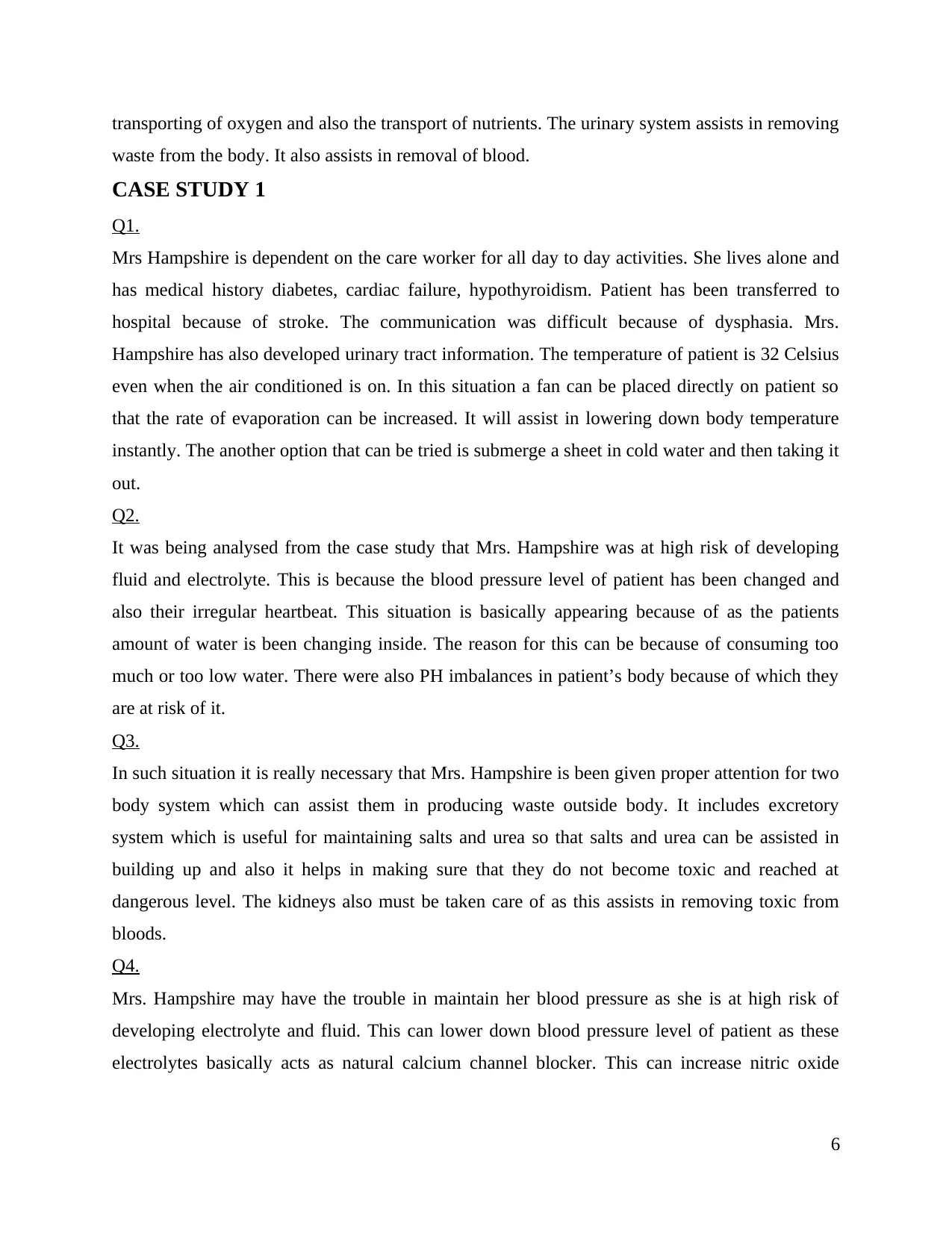
transporting of oxygen and also the transport of nutrients. The urinary system assists in removing
waste from the body. It also assists in removal of blood.
CASE STUDY 1
Q1.
Mrs Hampshire is dependent on the care worker for all day to day activities. She lives alone and
has medical history diabetes, cardiac failure, hypothyroidism. Patient has been transferred to
hospital because of stroke. The communication was difficult because of dysphasia. Mrs.
Hampshire has also developed urinary tract information. The temperature of patient is 32 Celsius
even when the air conditioned is on. In this situation a fan can be placed directly on patient so
that the rate of evaporation can be increased. It will assist in lowering down body temperature
instantly. The another option that can be tried is submerge a sheet in cold water and then taking it
out.
Q2.
It was being analysed from the case study that Mrs. Hampshire was at high risk of developing
fluid and electrolyte. This is because the blood pressure level of patient has been changed and
also their irregular heartbeat. This situation is basically appearing because of as the patients
amount of water is been changing inside. The reason for this can be because of consuming too
much or too low water. There were also PH imbalances in patient’s body because of which they
are at risk of it.
Q3.
In such situation it is really necessary that Mrs. Hampshire is been given proper attention for two
body system which can assist them in producing waste outside body. It includes excretory
system which is useful for maintaining salts and urea so that salts and urea can be assisted in
building up and also it helps in making sure that they do not become toxic and reached at
dangerous level. The kidneys also must be taken care of as this assists in removing toxic from
bloods.
Q4.
Mrs. Hampshire may have the trouble in maintain her blood pressure as she is at high risk of
developing electrolyte and fluid. This can lower down blood pressure level of patient as these
electrolytes basically acts as natural calcium channel blocker. This can increase nitric oxide
6
waste from the body. It also assists in removal of blood.
CASE STUDY 1
Q1.
Mrs Hampshire is dependent on the care worker for all day to day activities. She lives alone and
has medical history diabetes, cardiac failure, hypothyroidism. Patient has been transferred to
hospital because of stroke. The communication was difficult because of dysphasia. Mrs.
Hampshire has also developed urinary tract information. The temperature of patient is 32 Celsius
even when the air conditioned is on. In this situation a fan can be placed directly on patient so
that the rate of evaporation can be increased. It will assist in lowering down body temperature
instantly. The another option that can be tried is submerge a sheet in cold water and then taking it
out.
Q2.
It was being analysed from the case study that Mrs. Hampshire was at high risk of developing
fluid and electrolyte. This is because the blood pressure level of patient has been changed and
also their irregular heartbeat. This situation is basically appearing because of as the patients
amount of water is been changing inside. The reason for this can be because of consuming too
much or too low water. There were also PH imbalances in patient’s body because of which they
are at risk of it.
Q3.
In such situation it is really necessary that Mrs. Hampshire is been given proper attention for two
body system which can assist them in producing waste outside body. It includes excretory
system which is useful for maintaining salts and urea so that salts and urea can be assisted in
building up and also it helps in making sure that they do not become toxic and reached at
dangerous level. The kidneys also must be taken care of as this assists in removing toxic from
bloods.
Q4.
Mrs. Hampshire may have the trouble in maintain her blood pressure as she is at high risk of
developing electrolyte and fluid. This can lower down blood pressure level of patient as these
electrolytes basically acts as natural calcium channel blocker. This can increase nitric oxide
6
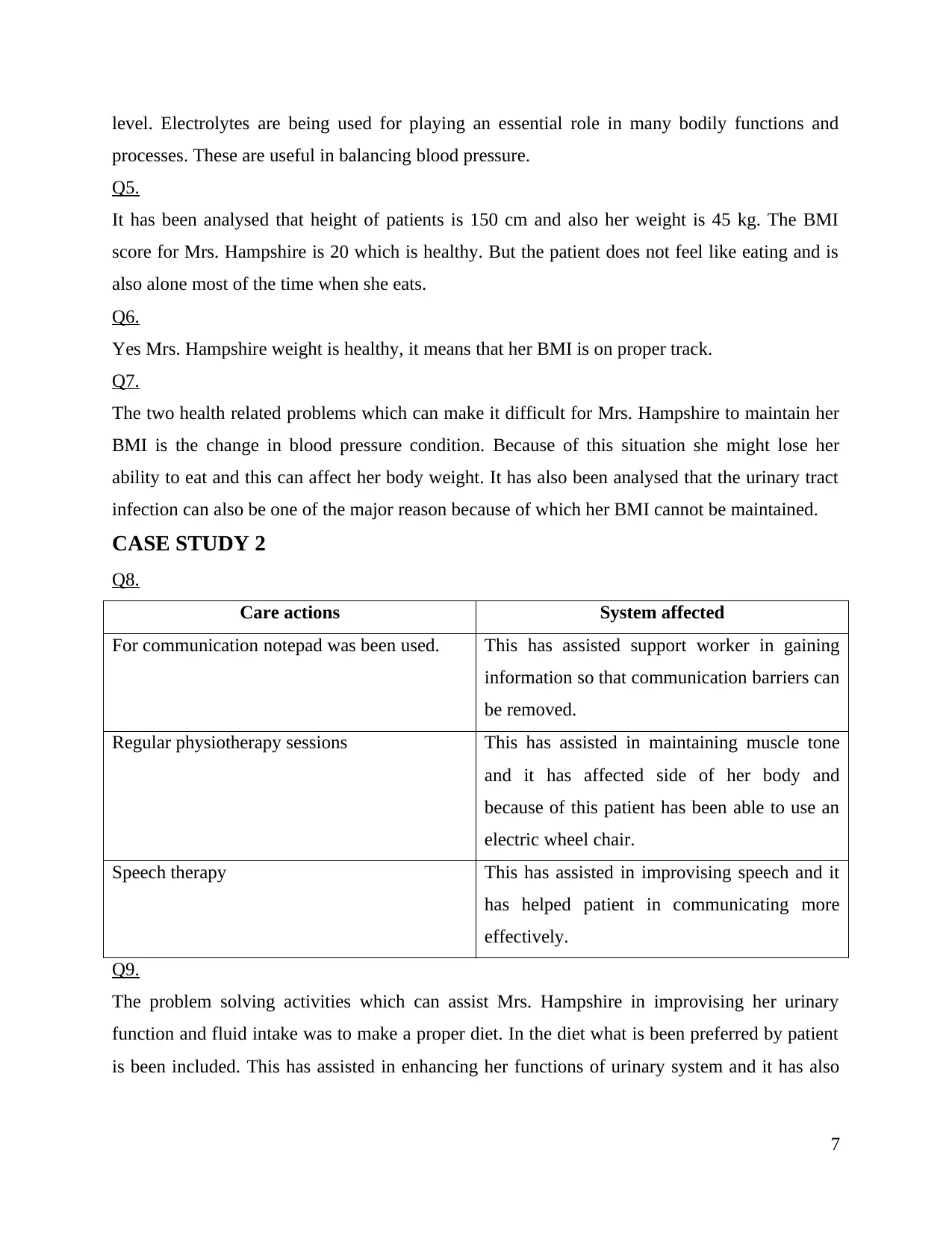
level. Electrolytes are being used for playing an essential role in many bodily functions and
processes. These are useful in balancing blood pressure.
Q5.
It has been analysed that height of patients is 150 cm and also her weight is 45 kg. The BMI
score for Mrs. Hampshire is 20 which is healthy. But the patient does not feel like eating and is
also alone most of the time when she eats.
Q6.
Yes Mrs. Hampshire weight is healthy, it means that her BMI is on proper track.
Q7.
The two health related problems which can make it difficult for Mrs. Hampshire to maintain her
BMI is the change in blood pressure condition. Because of this situation she might lose her
ability to eat and this can affect her body weight. It has also been analysed that the urinary tract
infection can also be one of the major reason because of which her BMI cannot be maintained.
CASE STUDY 2
Q8.
Care actions System affected
For communication notepad was been used. This has assisted support worker in gaining
information so that communication barriers can
be removed.
Regular physiotherapy sessions This has assisted in maintaining muscle tone
and it has affected side of her body and
because of this patient has been able to use an
electric wheel chair.
Speech therapy This has assisted in improvising speech and it
has helped patient in communicating more
effectively.
Q9.
The problem solving activities which can assist Mrs. Hampshire in improvising her urinary
function and fluid intake was to make a proper diet. In the diet what is been preferred by patient
is been included. This has assisted in enhancing her functions of urinary system and it has also
7
processes. These are useful in balancing blood pressure.
Q5.
It has been analysed that height of patients is 150 cm and also her weight is 45 kg. The BMI
score for Mrs. Hampshire is 20 which is healthy. But the patient does not feel like eating and is
also alone most of the time when she eats.
Q6.
Yes Mrs. Hampshire weight is healthy, it means that her BMI is on proper track.
Q7.
The two health related problems which can make it difficult for Mrs. Hampshire to maintain her
BMI is the change in blood pressure condition. Because of this situation she might lose her
ability to eat and this can affect her body weight. It has also been analysed that the urinary tract
infection can also be one of the major reason because of which her BMI cannot be maintained.
CASE STUDY 2
Q8.
Care actions System affected
For communication notepad was been used. This has assisted support worker in gaining
information so that communication barriers can
be removed.
Regular physiotherapy sessions This has assisted in maintaining muscle tone
and it has affected side of her body and
because of this patient has been able to use an
electric wheel chair.
Speech therapy This has assisted in improvising speech and it
has helped patient in communicating more
effectively.
Q9.
The problem solving activities which can assist Mrs. Hampshire in improvising her urinary
function and fluid intake was to make a proper diet. In the diet what is been preferred by patient
is been included. This has assisted in enhancing her functions of urinary system and it has also
7
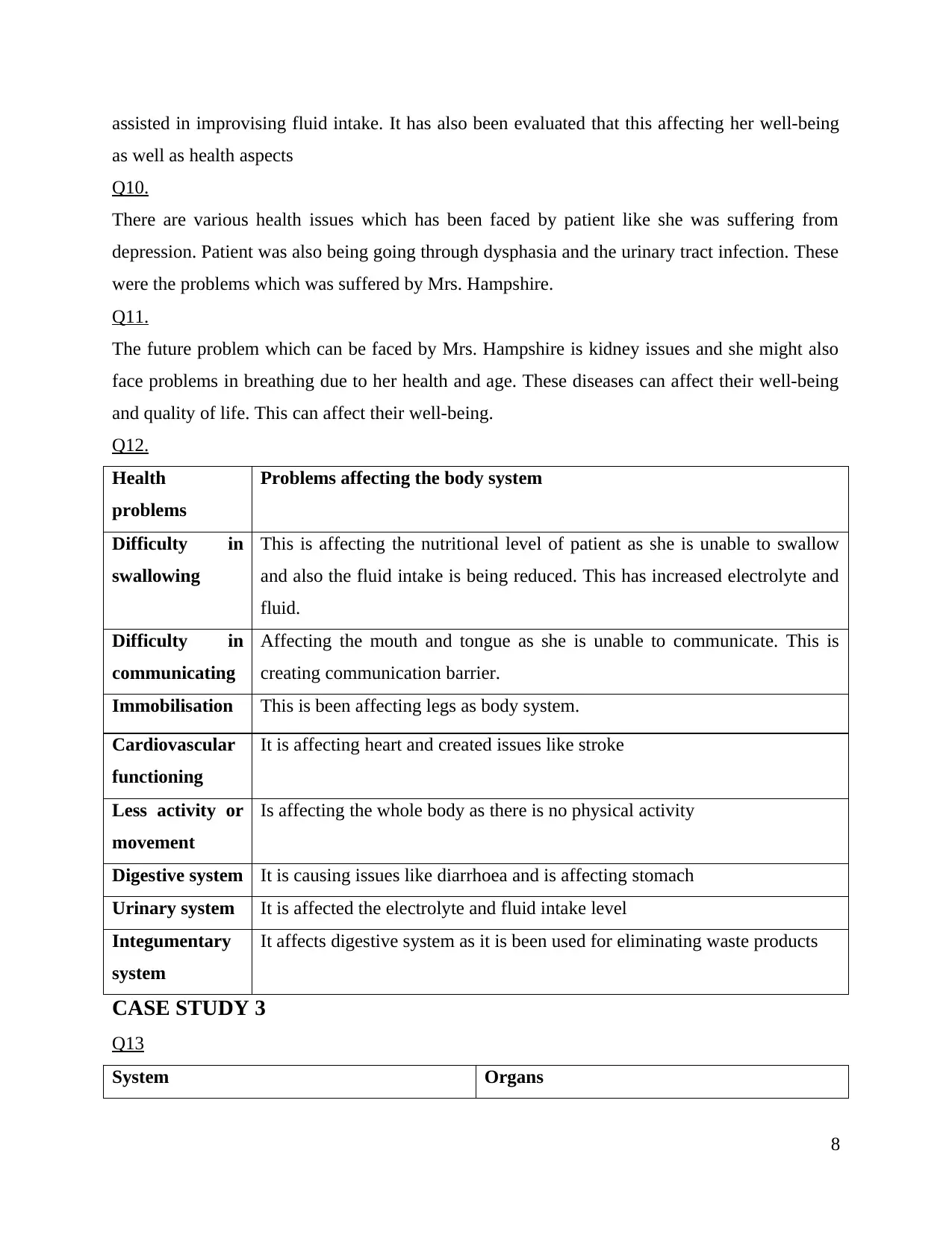
assisted in improvising fluid intake. It has also been evaluated that this affecting her well-being
as well as health aspects
Q10.
There are various health issues which has been faced by patient like she was suffering from
depression. Patient was also being going through dysphasia and the urinary tract infection. These
were the problems which was suffered by Mrs. Hampshire.
Q11.
The future problem which can be faced by Mrs. Hampshire is kidney issues and she might also
face problems in breathing due to her health and age. These diseases can affect their well-being
and quality of life. This can affect their well-being.
Q12.
Health
problems
Problems affecting the body system
Difficulty in
swallowing
This is affecting the nutritional level of patient as she is unable to swallow
and also the fluid intake is being reduced. This has increased electrolyte and
fluid.
Difficulty in
communicating
Affecting the mouth and tongue as she is unable to communicate. This is
creating communication barrier.
Immobilisation This is been affecting legs as body system.
Cardiovascular
functioning
It is affecting heart and created issues like stroke
Less activity or
movement
Is affecting the whole body as there is no physical activity
Digestive system It is causing issues like diarrhoea and is affecting stomach
Urinary system It is affected the electrolyte and fluid intake level
Integumentary
system
It affects digestive system as it is been used for eliminating waste products
CASE STUDY 3
Q13
System Organs
8
as well as health aspects
Q10.
There are various health issues which has been faced by patient like she was suffering from
depression. Patient was also being going through dysphasia and the urinary tract infection. These
were the problems which was suffered by Mrs. Hampshire.
Q11.
The future problem which can be faced by Mrs. Hampshire is kidney issues and she might also
face problems in breathing due to her health and age. These diseases can affect their well-being
and quality of life. This can affect their well-being.
Q12.
Health
problems
Problems affecting the body system
Difficulty in
swallowing
This is affecting the nutritional level of patient as she is unable to swallow
and also the fluid intake is being reduced. This has increased electrolyte and
fluid.
Difficulty in
communicating
Affecting the mouth and tongue as she is unable to communicate. This is
creating communication barrier.
Immobilisation This is been affecting legs as body system.
Cardiovascular
functioning
It is affecting heart and created issues like stroke
Less activity or
movement
Is affecting the whole body as there is no physical activity
Digestive system It is causing issues like diarrhoea and is affecting stomach
Urinary system It is affected the electrolyte and fluid intake level
Integumentary
system
It affects digestive system as it is been used for eliminating waste products
CASE STUDY 3
Q13
System Organs
8
Secure Best Marks with AI Grader
Need help grading? Try our AI Grader for instant feedback on your assignments.
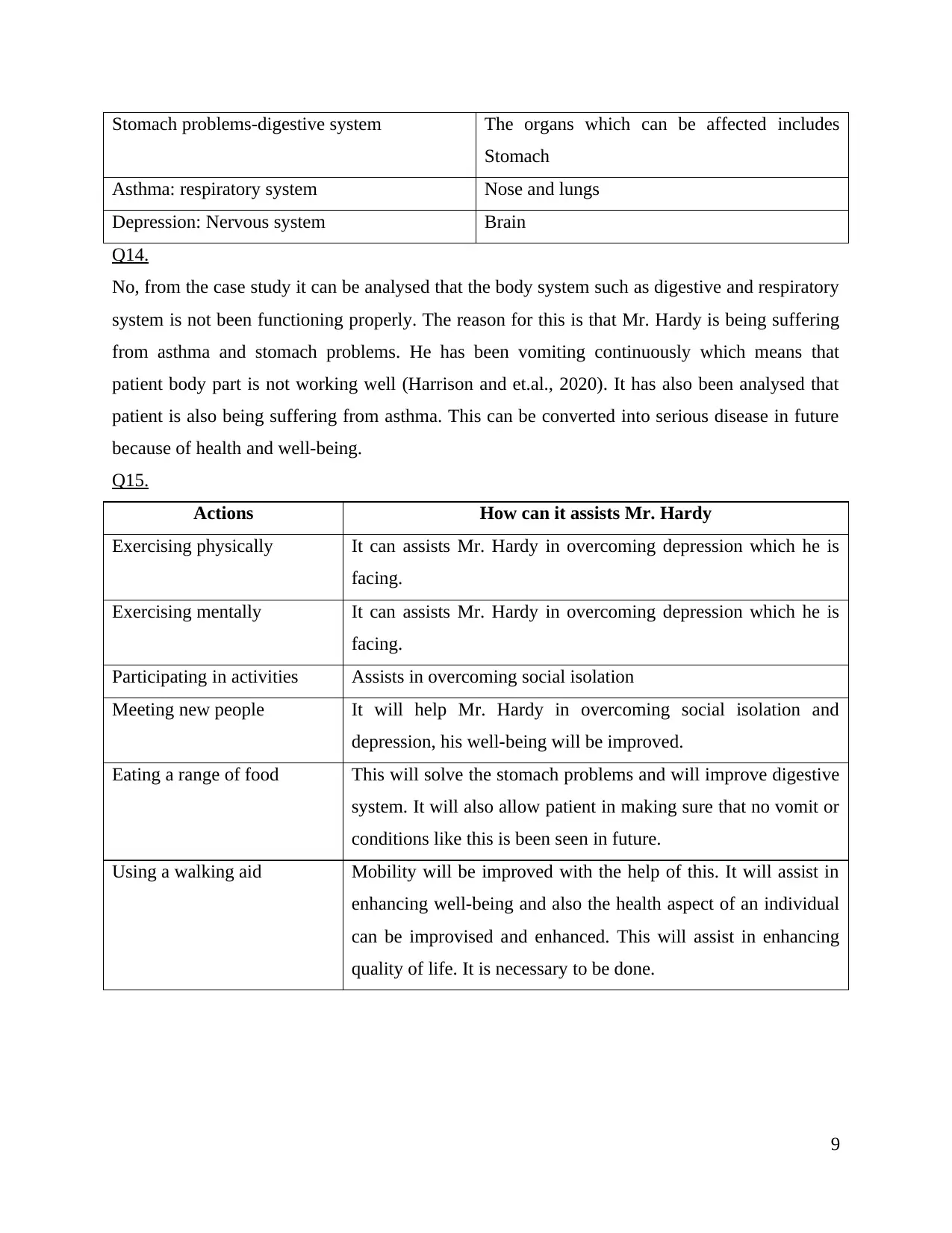
Stomach problems-digestive system The organs which can be affected includes
Stomach
Asthma: respiratory system Nose and lungs
Depression: Nervous system Brain
Q14.
No, from the case study it can be analysed that the body system such as digestive and respiratory
system is not been functioning properly. The reason for this is that Mr. Hardy is being suffering
from asthma and stomach problems. He has been vomiting continuously which means that
patient body part is not working well (Harrison and et.al., 2020). It has also been analysed that
patient is also being suffering from asthma. This can be converted into serious disease in future
because of health and well-being.
Q15.
Actions How can it assists Mr. Hardy
Exercising physically It can assists Mr. Hardy in overcoming depression which he is
facing.
Exercising mentally It can assists Mr. Hardy in overcoming depression which he is
facing.
Participating in activities Assists in overcoming social isolation
Meeting new people It will help Mr. Hardy in overcoming social isolation and
depression, his well-being will be improved.
Eating a range of food This will solve the stomach problems and will improve digestive
system. It will also allow patient in making sure that no vomit or
conditions like this is been seen in future.
Using a walking aid Mobility will be improved with the help of this. It will assist in
enhancing well-being and also the health aspect of an individual
can be improvised and enhanced. This will assist in enhancing
quality of life. It is necessary to be done.
9
Stomach
Asthma: respiratory system Nose and lungs
Depression: Nervous system Brain
Q14.
No, from the case study it can be analysed that the body system such as digestive and respiratory
system is not been functioning properly. The reason for this is that Mr. Hardy is being suffering
from asthma and stomach problems. He has been vomiting continuously which means that
patient body part is not working well (Harrison and et.al., 2020). It has also been analysed that
patient is also being suffering from asthma. This can be converted into serious disease in future
because of health and well-being.
Q15.
Actions How can it assists Mr. Hardy
Exercising physically It can assists Mr. Hardy in overcoming depression which he is
facing.
Exercising mentally It can assists Mr. Hardy in overcoming depression which he is
facing.
Participating in activities Assists in overcoming social isolation
Meeting new people It will help Mr. Hardy in overcoming social isolation and
depression, his well-being will be improved.
Eating a range of food This will solve the stomach problems and will improve digestive
system. It will also allow patient in making sure that no vomit or
conditions like this is been seen in future.
Using a walking aid Mobility will be improved with the help of this. It will assist in
enhancing well-being and also the health aspect of an individual
can be improvised and enhanced. This will assist in enhancing
quality of life. It is necessary to be done.
9
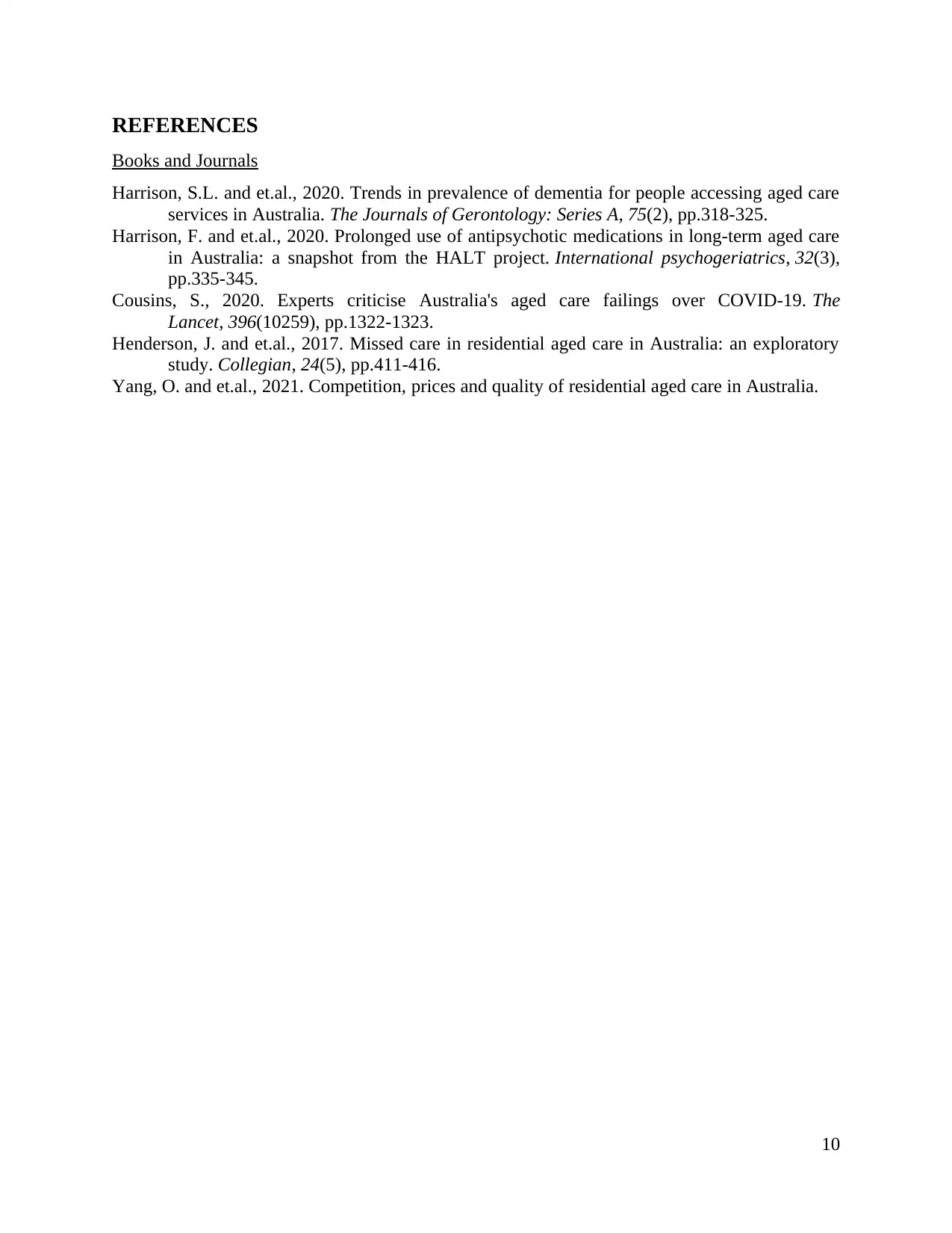
REFERENCES
Books and Journals
Harrison, S.L. and et.al., 2020. Trends in prevalence of dementia for people accessing aged care
services in Australia. The Journals of Gerontology: Series A, 75(2), pp.318-325.
Harrison, F. and et.al., 2020. Prolonged use of antipsychotic medications in long-term aged care
in Australia: a snapshot from the HALT project. International psychogeriatrics, 32(3),
pp.335-345.
Cousins, S., 2020. Experts criticise Australia's aged care failings over COVID-19. The
Lancet, 396(10259), pp.1322-1323.
Henderson, J. and et.al., 2017. Missed care in residential aged care in Australia: an exploratory
study. Collegian, 24(5), pp.411-416.
Yang, O. and et.al., 2021. Competition, prices and quality of residential aged care in Australia.
10
Books and Journals
Harrison, S.L. and et.al., 2020. Trends in prevalence of dementia for people accessing aged care
services in Australia. The Journals of Gerontology: Series A, 75(2), pp.318-325.
Harrison, F. and et.al., 2020. Prolonged use of antipsychotic medications in long-term aged care
in Australia: a snapshot from the HALT project. International psychogeriatrics, 32(3),
pp.335-345.
Cousins, S., 2020. Experts criticise Australia's aged care failings over COVID-19. The
Lancet, 396(10259), pp.1322-1323.
Henderson, J. and et.al., 2017. Missed care in residential aged care in Australia: an exploratory
study. Collegian, 24(5), pp.411-416.
Yang, O. and et.al., 2021. Competition, prices and quality of residential aged care in Australia.
10
1 out of 12
Related Documents
Your All-in-One AI-Powered Toolkit for Academic Success.
+13062052269
info@desklib.com
Available 24*7 on WhatsApp / Email
![[object Object]](/_next/static/media/star-bottom.7253800d.svg)
Unlock your academic potential
© 2024 | Zucol Services PVT LTD | All rights reserved.





